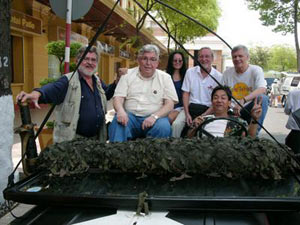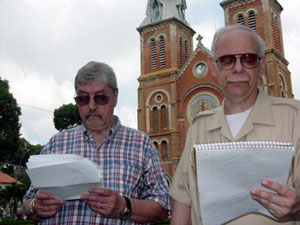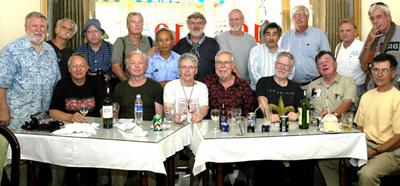"Vietnam is what we had instead of happy childhoods."
That is how writer Michael Herr described the coming of age of the photographers and reporters who covered the Vietnam War.
Last month, 30 years after the North Vietnamese drove their tanks through the gates of the presidential palace in Saigon, ending a 15-year conflict between the forces of the United States and the communists, some 60 journalists returned to the "The Paris of the Orient" to reconnect with their friends and memories.
 |
Photographers who spent much of a decade covering the Vietnam War prepare to share a ride in a restored U.S. Army jeep owned
by former UPI Saigon photographer Hoang Van Cuong, in front of the Continental Palace hotel.
From left, Dirck Halstead (UPI/Time 1965-1975);
Horst Faas (AP Saigon 1963-1975); Hugh Van Es (UPI), who took the famous shot of people boarding one of the last helicopters in 1975 during the evacuation; Bob Davis,
freelance(1970-1975); Cuong, who now drives tourists and journalists around Saigon in the jeep.
In the back is Annir Van Es.
Photograph by Alison Beck |
Vietnam was probably the last "glamorous" war for journalists. Unlike Bosnia, the Gulf War and Iraq, where creature comforts are in short supply, Saigon was a Graham Greene-type of place, full of intrigue, sex and great food. If you survived in the combat zones, at the end of the day you could be sipping a glass of wine or a beer on the luxurious terrace of the Continental Palace, or haunting the bars and fast company on Tudo Street. It was the Las Vegas of war zones.
More than 70 western journalists lost their lives there. It was probably the most costly war in terms of journalist casualties in history. At a memorial service in front of the cathedral in the center of Saigon, AP's Richard Pyle and Glen MacDonald, a former ABC correspondent, commemorated the toll.
Photographers Dickey Chapelle, Bob Ellison, Oliver Noonan, Gilles Caron, Dana Stone, Sean Flynn, Kyoichi Sawada, Henri Huet, Larry Burrows, Kent Potter and Michel Laurent were some of the names that were called out to their colleagues who had gathered in the square in 100-degree heat.
 |
|
Former chief, AP Saigon bureau Richard Pyle and former ABC correspondent Glen MacDonald read the list of the 70
journalists who were killed in Vietnam, Cambodia, and Laos between 1965 and 1975 to a gathering of Vietnam
media veterans in front of the National Cathedral in Saigon.
Photograph by Dirck Halstead |
But while they wanted to pay tribute to lost friends, this was a last hurrah for the photographers who had made the journey. Most of them are greyer, certainly heavier, but once they got back to Saigon, these 60+-year-olds reverted back to what they had been like 30 years ago.
Some haven't changed that much. Tim Page, who was the model for the Dennis Hopper character in "Apocalypse Now," and Al Rockoff, who was portrayed by John Malkovich in "The Killing Fields," were pulling out tins of grass on bus tours and in private parties.
Every night was a party – ranging from the stately Majestic Hotel on the riverfront, to the roof of the "Rex," a famous American officers' quarters during the war that was blown up at least once, to a cruise on the Mekong River aboard the three-level "Saigon" cruise ship.
Among the photographers who attended were Nik Wheeler, who has gone on to produce travel essays on the Caribbean for books; Nick Ut, who photographed the Pulitzer Prize-winning shot of the young Vietnamese girl running from a napalm strike; Hugh Van Es, whose photograph of desperate Americans and Vietnamese clambering aboard one of the last helicopters during the evacuation became an icon; Bob Davis, who went on to create a photo agency in Hong Kong; Steve Northup, who became an editor of the newspaper in Santa Fe, New Mexico; Matt Franjola, and of course, Horst Faas, the recently retired European Photo Editor for The Associated Press, a two-time Pulitzer winner, and now an editor for The Digital Journalist. I joyously joined my friends, who dated back to the time I opened the UPI picture bureau in Saigon.
 |
|
SAIGON:4/29/05: Former UPI photographers and reporters who covered the Vietnam War pose for a picture by Tim Page in front of the old UPI bureau: (L to R from back) Van Thanh Lim, Steve Northup, Bill Reilly, Joe Galloway, Nik Wheeler,
(front) Martin Stuart Fox and Hoang Van Cuong, the UPI photographer who spent seven years in a reeducation camp, and now uses the jeep to escort tourists and journalists around Saigon.
Photograph by Alison Beck |
But it was also a time to reunite with our Vietnamese friends, who had produced some of the great pictures of the war and worked in our bureaus. Among them were Van Thanh Lim, who was the "fixer" for the UPI bureau and is now an entrepreneur in Saigon; Hoang Van Cuong, a former UPI photographer who was sent to the reeducation camps for seven years after the collapse, and Hoang Van Tham, who perhaps had the most amazing story of all.
I had hired Tham in 1965. He had been a night watchman for the UPI bureau at 19 Ngo Duc Ke. I taught him how to process film, and he soon became the UPI darkroom man.
For the next 10 years Tham either slept in the darkroom, or moved around in the shadows. When the North Vietnamese took control and started to look for people who had worked for the Americans, Tham was nowhere to be found. He had melted back into the shadows. For the past two decades, Tham has been taking pictures of tourists around the central square of Saigon. Somehow he had slipped under the eyes of the party, and being no threat to Hanoi, has managed to continue his photography.
Another Vietnamese photographer, Hoang Van Cuong, after spending years in reeducation camps, bought an old U.S. Army jeep, had it restored to prime condition, and now escorts journalists and tourists around Saigon.
 |
Tim Page and Jim Caccavo at the Requiem exhibition in Saigon.
The show is on permanent display at the War Rememberance Museum and has been viewed by more than 2 million people.
Photograph by Hugh Van Es |
Perhaps the most deeply affecting part of the visit was the visit to The War Remembrance Museum in Saigon. Amidst all the old helicopters, planes, and tanks was a building devoted entirely to "Requiem," the project organized several years ago by Horst Faas and Tim Page, featuring the photographs taken during the war by fallen western and Vietnamese photographers. Most of us were very familiar with the work, but seeing the photos on the walls of that museum, and watching hundreds of Vietnamese pass through and stand in rapt, reverent attention to the work, and see the faces of our dead comrades, and understand the commonality of photojournalism, was an experience that touched us all. To date, more than two million visitors have passed through the exhibit. The museum is in the process of expanding, and the "Requiem" exhibit will have a permanent place on its second floor.
What all the photographers found was that Saigon really hadn't changed that much. The bars along Tudo Street that used to beckon servicemen during the war were gone.
But the stately street, laid out in classic, wide-open French- style, was still there, with the cooling breezes from the Mekong River and the essences of the Orient. There were more great restaurants, more luxury hotels, but Saigon was still Saigon. And we were still 30-year-old journalists with the world in front of us.
Horst Faas and Edie Lederer, the AP U.N. bureau chief, had organized this reunion. Horst went on to Hanoi to start the second IMMF workshop for Vietnamese photographers. He had no sooner gotten there than he was stricken by a burst blood vessel near his spine. Thanks to the heroic efforts of the doctors in Hanoi, he was stabilized and evacuated to Bangkok, where he underwent treatment for paralysis from the waist down. Horst has since been transferred to a rehabilitation clinic in Bavaria.
What he and Edie gave to all those journalists who returned to Saigon for this reunion, and were able to reconnect with their youth and former friends, may be one of his greatest gifts.
 |
|
Some of the staff of United Press International who covered the Vietnam War from 1965-1975 assemble for a group photo in the former UPI bureau at 19 Ngo Duc Ke.
From left (front) Martin Stuart Fox,Ray Wilkenson,Bill Reilly(UPI Radio),Mike Malloy, who was the first Saigon bureau chief,
Ken Englade,Joe Galloway, who wrote the book"We were Soldiers Once and Young",Tom Cheatham.
(rear) Roger Norum,UPI Radio,Al Rockoff,who covered the fall of Cambodia, and was played by John Malcovich in the film "The Killing Fields" ,David Terry, Nik Wheeler,Hoang Van Tom, who was the darkroom man for 10 years,Dirck Halstead, who opened the Saigon picture bureau in 1965,Hugh Van Es,Vanh Thanh Lim, Steve Northup, Jim Cacavo, and Tim Page,who was the model for the wild photographer played by Dennis Hopper in "Apocalypse Now"
Photograph by Alison Beck |

